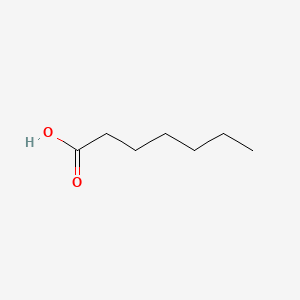| MeSH term | MeSH ID | Detail |
|---|---|---|
| Olfaction Disorders | D000857 | 17 associated lipids |
| Byssinosis | D002095 | 11 associated lipids |
| Mitochondrial Diseases | D028361 | 25 associated lipids |
HEPTANOIC ACID
HEPTANOIC ACID is a lipid of Fatty Acyls (FA) class. Heptanoic acid is associated with abnormalities such as Dehydration. The involved functions are known as Process, Anabolism, inhibitors, Oxidation and fatty acid oxidation. The related lipids are Heptanoates and undecanoic acid.
Cross Reference
Introduction
To understand associated biological information of HEPTANOIC ACID, we collected biological information of abnormalities, associated pathways, cellular/molecular locations, biological functions, related genes/proteins, lipids and common seen animal/experimental models with organized paragraphs from literatures.
What diseases are associated with HEPTANOIC ACID?
HEPTANOIC ACID is suspected in Dehydration and other diseases in descending order of the highest number of associated sentences.
Related references are mostly published in these journals:
| Disease | Cross reference | Weighted score | Related literature |
|---|
Possible diseases from mapped MeSH terms on references
We collected disease MeSH terms mapped to the references associated with HEPTANOIC ACID
PubChem Associated disorders and diseases
What pathways are associated with HEPTANOIC ACID
There are no associated biomedical information in the current reference collection.
PubChem Biomolecular Interactions and Pathways
Link to PubChem Biomolecular Interactions and PathwaysWhat cellular locations are associated with HEPTANOIC ACID?
There are no associated biomedical information in the current reference collection.
What functions are associated with HEPTANOIC ACID?
Related references are published most in these journals:
| Function | Cross reference | Weighted score | Related literatures |
|---|
What lipids are associated with HEPTANOIC ACID?
Related references are published most in these journals:
| Lipid concept | Cross reference | Weighted score | Related literatures |
|---|
What genes are associated with HEPTANOIC ACID?
There are no associated biomedical information in the current reference collection.
What common seen animal models are associated with HEPTANOIC ACID?
There are no associated biomedical information in the current reference collection.
NCBI Entrez Crosslinks
All references with HEPTANOIC ACID
Download all related citations| Authors | Title | Published | Journal | PubMed Link |
|---|---|---|---|---|
| Trabado S et al. | Estradiol levels in men with congenital hypogonadotropic hypogonadism and the effects of different modalities of hormonal treatment. | 2011 | Fertil. Steril. | pmid:21536274 |
| Mitsui S et al. | Genetic visualization of the secondary olfactory pathway in Tbx21 transgenic mice. | 2011 | Neural Syst Circuits | pmid:22330144 |
| Kinross JM et al. | Gut microbiome-host interactions in health and disease. | 2011 | Genome Med | pmid:21392406 |
| Banel A et al. | Application of headspace solid-phase microextraction followed by gas chromatography-mass spectrometry to determine short-chain alkane monocarboxylic acids in aqueous samples. | 2011 | Anal Bioanal Chem | pmid:21107976 |
| Wei J et al. | Ecological trade-offs between jasmonic acid-dependent direct and indirect plant defences in tritrophic interactions. | 2011 | New Phytol. | pmid:21039561 |
| Nazir N et al. | Evaluation of antioxidant and antimicrobial activities of Bergenin and its derivatives obtained by chemoenzymatic synthesis. | 2011 | Eur J Med Chem | pmid:21474216 |
| Inoue S and Fujihara S | Liquid-liquid biphasic synthesis of layered zinc hydroxides intercalated with long-chain carboxylate ions and their conversion into ZnO nanostructures. | 2011 | Inorg Chem | pmid:21434621 |
| Ekström L et al. | Bioavailability of testosterone enanthate dependent on genetic variation in the phosphodiesterase 7B but not on the uridine 5'-diphospho-glucuronosyltransferase (UGT2B17) gene. | 2011 | Pharmacogenet. Genomics | pmid:21383644 |
| Xia M et al. | Identification of quaternary ammonium compounds as potent inhibitors of hERG potassium channels. | 2011 | Toxicol. Appl. Pharmacol. | pmid:21362439 |
| Wang PC et al. | Sesquiterpenoids and lignans from the roots of Valeriana officinalis L. | 2011 | Chem. Biodivers. | pmid:22006719 |
